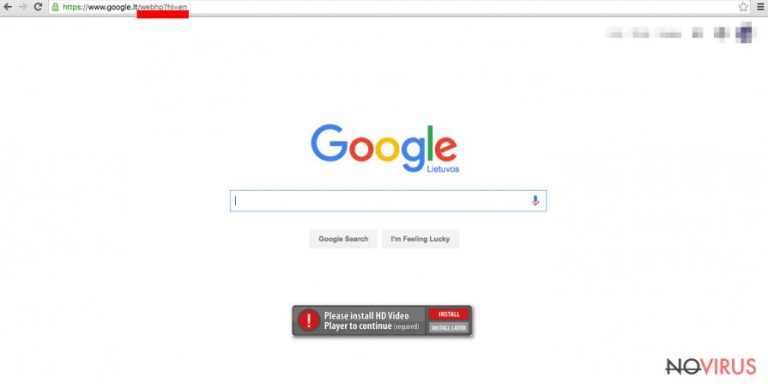Uninstall Google WebHP virus (Uninstall Guide) - Nov 2020 updated
Google WebHP virus Removal Guide
Description of Google WebHP virus
WebHP browser hijacker – a potentially unwanted program that impedes users overall browsing performance

WebHP virus is a browser hijacker that, after installation, will redirect all searches through google.com/webhp. This kind of potentially unwanted programs (PUPs) are created with the sole purpose – to increase revenue by redirecting to sponsored sites, showing them first in any search results, displaying various ad banners, and so on. It automatically replaces users' homepage, search engine, new tab preferences.
The newly appointed Google WebHP virus search engine appears like google.com, but right after opening it user can spot some differences. First of all, there's an advertisement for some random software right below the search window. Then when any search is made, sponsored website results are highlighted and shown at the top.
WebHp isn't a product of Google. These kinds of PUPs can redirect users to sites with malicious content and get them in real trouble. After entering such sites or clicking on mischievous banners users might unknowingly start a chain reaction that infects their devices with serious malware, like ransomware or trojans. So although, WebHP isn't classified as malware, experts advise to delete it before more harm came their way.
| Name | Google WebHP virus, WebHP virus |
|---|---|
| Type | Browser hijacker |
| Issues | Original browser setting such as search engine, new tab, homepage are changed to google.com/webhp |
| Distribution | Usually, PUP spread via freeware bundles |
| Removal | To remove WebHP virus, and PUPs alike, users should use a reliable anti-malware software, that can automatically detect, isolate, and remove any suspicious files, applications |
| System repair | Use FortectIntego to detect any changes made to system files or system settings and restore them. |
Google WebHP virus sneaks into computers while installing freeware bundles. Users should always keep an eye out for what they agree to add to their computer.
Since this browser hijacker looks precisely like Google search engine, it tricks people into thinking that it's the real thing. Only an attentive user will distinguish the difference. If users do not spot the intruder for a while, Google WebHP virus removal gets more difficult.
If this PUP ended up on the users' computer without his knowledge and is disturbing his/her browsing experience, consider uninstalling the app and running a full system scan with FortectIntego to revert any changes the WebHP virus might have caused to system files and settings.
It is known that this particular PUP pops into devices along with another browser hijacker – Conduit Toolbar. Experts advising to remove Google WebHP virus alongside other threats. If the computer user isn't highly experienced, the process can be trusted to professionals like SpyHunter 5Combo Cleaner and Malwarebytes to do the dirty work for them.

Methods of browser hijackers distribution
The most frequent method to distribute browser hijackers is with freeware bundles. Once installing some software, don't rush. Always choose Custom or Advanced installation instead of using the preselected Default, Quick or Standard option. Read the most boring thing in the world – Terms of Use/Privacy Policy documents. It could save you from a massive headache.
After choosing Advanced installation, deselect all pre-ticked boxes of suspicious-looking apps or programs that users are not interested in. That's how the potentially unwanted programs slither their way into computer systems.
Guidelines for beginners on WebHP removal
Google WebHP virus might not look like serious malware, but it is still a dangerous app, and it is strongly recommended to remove it before more damage is done to the affected machine. Anti-malware software should be used to clear out the threats from the computer.
Follow the instructions below this article to safely remove Google WebHP from the device. Afterward, run a system check with optimizer or system tool to automatically detect and revert any changes this PUP might have done to system settings and system files.
You may remove virus damage with a help of FortectIntego. SpyHunter 5Combo Cleaner and Malwarebytes are recommended to detect potentially unwanted programs and viruses with all their files and registry entries that are related to them.
Getting rid of Google WebHP virus. Follow these steps
Uninstall Google WebHP in Windows systems
Terminate suspicious programs from Windows 10/8 machines by following these instructions:
- Type Control Panel into Windows search and once the result shows up hit Enter.
- Under Programs, choose Uninstall a program.

- Find components related to suspicious programs.
- Right-click on the application and select Uninstall.
- Click Yes when User Account Control shows up.

- Wait for the process of uninstallation to be done and click OK.
Windows 7/XP instructions:
- Click on Windows Start and go to Control Panel on the right pane.
- Choose Add/Remove Programs.

- Select Uninstall a program under Programs in Control Panel.
- Click once on the unwanted application.
- Click Uninstall/Change at the top.
- Confirm with Yes.
- Click OK and finish the removal.
Uninstall Google WebHP in Mac OS X system
-
Users who use OS X should click on Go button, which can be found at the top left corner of the screen and select Applications.

-
Wait until you see Applications folder and look for Google WebHP or any other suspicious programs on it. Now right click on every of such entries and select Move to Trash.

Eliminate Google WebHP virus from Microsoft Edge browser
Delete suspicious extensions from MS Edge:
- Go to the Menu by clicking on the three horizontal dots at the top-right.
- Then pick Extensions.

- Choose the unwanted add-ons on the list and click on the Gear icon.
- Click on Uninstall at the bottom.
Clear cookies and other data:
- Click on the Menu and from the context menu select Privacy & security.
- Under Clear browsing data, select Choose what to clear.

- Choose everything except passwords, and click on Clear.
Alter new tab and homepage settings:
- Click the menu icon and choose Settings.
- Then find On startup section.
- Click Disable if you found any suspicious domain.
Reset MS Edge fully:
- Click on the keyboard Ctrl + Shift + Esc to open Task Manager.
- Choose More details arrow at the bottom.
- Go to Details tab.

- Now scroll down and locate every entry with Microsoft Edge name in it.
- Right-click on each of them and select End Task to stop MS Edge from running.
When none of the above solves the issue, you might need an advanced Edge reset method, but you need to backup your data before proceeding.
- Find the following folder on the PC: C:\\Users\\%username%\\AppData\\Local\\Packages\\Microsoft.MicrosoftEdge_8wekyb3d8bbwe.
- Press Ctrl + A on your keyboard to select all folders.

- Right-click on the selection and choose Delete
- Right-click on the Start button and pick Windows PowerShell (Admin).

- Copy and paste the following command, and then press Enter:
Get-AppXPackage -AllUsers -Name Microsoft.MicrosoftEdge | Foreach {Add-AppxPackage -DisableDevelopmentMode -Register “$($_.InstallLocation)\\AppXManifest.xml” -Verbose
Instructions for Chromium-based Edge
Delete extensions:
- Open Edge and click Settings.
- Then find Extensions.

- Delete unwanted extensions with the Remove.
Clear cache and site data:
- Click on Menu and then Settings.
- Find Privacy and services.
- Locate Clear browsing data, then click Choose what to clear.

- Time range.
- Click All time.
- Select Clear now.
Reset Chromium-based MS Edge browser fully:
- Go to Settings.
- On the left side, choose Reset settings.

- Select Restore settings to their default values.
- Click Reset.
Delete Google WebHP from Mozilla Firefox (FF)
Remove suspicious Firefox extensions:
- Open Mozilla Firefox browser and click on the three horizontal lines at the top-right to open the menu.
- Select Add-ons in the context menu.

- Choose plugins that are creating issues and select Remove.
Reset the homepage on the browser:
- Click three horizontal lines at the top right corner.
- This time select Options.
- Under Home section, enter your preferred site for the homepage that will open every time you launch Mozilla Firefox.
Clear cookies and site data:
- Click Menu and pick Options.
- Find the Privacy & Security section.
- Scroll down to choose Cookies and Site Data.

- Click on Clear Data… option.
- Click Cookies and Site Data, Cached Web Content and press Clear.
Reset Mozilla Firefox:
If none of the steps above helped you, reset Mozilla Firefox as follows:
- Open Mozilla Firefox and go to the menu.
- Click Help and then choose Troubleshooting Information.

- Locate Give Firefox a tune-up section, click on Refresh Firefox…
- Confirm the action by pressing on Refresh Firefox on the pop-up.

Chrome browser reset
Find and remove suspicious extensions from Google Chrome:
- In Google Chrome, open the Menu by clicking three vertical dots at the top-right corner.
- Select More tools > Extensions.
- Once the window opens, you will see all the installed extensions.
- Find any suspicious add-ons related to any PUP.
- Uninstall them by clicking Remove.

Clear cache and web data from Chrome:
- Click the Menu and select Settings.
- Find Privacy and security section.
- Choose Clear browsing data.
- Select Browsing history.
- Cookies and other site data, also Cached images and files.
- Click Clear data.

Alter settings of the homepage:
- Go to the menu and choose Settings.
- Find odd entries in the On startup section.
- Click on Open a specific or set of pages.
- Then click on three dots and look for the Remove option.
Reset Google Chrome fully:
You might need to reset Google Chrome and properly eliminate all the unwanted components:
- Go to Chrome Settings.
- Once there, scroll down to expand Advanced section.
- Scroll down to choose Reset and clean up.
- Click Restore settings to their original defaults.
- Click Reset settings again.

Delete Google WebHP from Safari
Get rid of questionable extensions from Safari:
- Click Safari.
- Then go to Preferences…

- Choose Extensions on the menu.
- Select the unwanted extension and then pick Uninstall.
Clear cookies from Safari:
- Click Safari.
- Choose Clear History…

- From the drop-down menu under Clear, find and pick all history.
- Confirm with Clear History.
Reset Safari fully:
- Click Safari and then Preferences…
- Choose the Advanced tab.
- Tick the Show Develop menu in the menu bar.
- From the menu bar, click Develop.

- Then select Empty Caches.
Even if you have completed all the steps above, we still strongly recommend you to scan your computer system with a powerful anti-malware software. It is advisable to do that because an automatic malware removal tool can detect and delete all remains of Google WebHP, for instance, its registry keys. The anti-malware program can help you to easily detect and eliminate possibly dangerous software and malicious viruses in an easy way. You can use any of our top-rated malware removal programs: FortectIntego, SpyHunter 5Combo Cleaner or Malwarebytes.
How to prevent from getting browser hijackers
Securely connect to your website wherever you are
Sometimes you may need to log in to a content management system or server more often, especially if you are actively working on a blog, website, or different project that needs constant maintenance or that requires frequent content updates or other changes. Avoiding this problem can be easy if you choose a dedicated/fixed IP address. It's a static IP address that only belongs to a specific device and does not change when you are in different locations.
VPN service providers such as Private Internet Access can help you with these settings. This tool can help you control your online reputation and successfully manage your projects wherever you are. It is important to prevent different IP addresses from connecting to your website. With a dedicated/fixed IP address, VPN service, and secure access to a content management system, your project will remain secure.
Recover files damaged by a dangerous malware attack
Despite the fact that there are various circumstances that can cause data to be lost on a system, including accidental deletion, the most common reason people lose photos, documents, videos, and other important data is the infection of malware.
Some malicious programs can delete files and prevent the software from running smoothly. However, there is a greater threat from the dangerous viruses that can encrypt documents, system files, and images. Ransomware-type viruses focus on encrypting data and restricting users’ access to files, so you can permanently lose personal data when you download such a virus to your computer.
The ability to unlock encrypted files is very limited, but some programs have a data recovery feature. In some cases, the Data Recovery Pro program can help recover at least some of the data that has been locked by a virus or other cyber infection.


